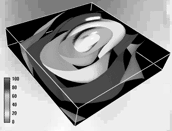Math Awareness Month 1999
April 22, 1999

Propagation of an electric signal through a normal heart. Image from James Keener and A.V. Panfilov, as shown on the 1999 Math Awareness Month poster.
As readers will have guessed, the theme of Mathematics Awareness Month for 1999 is Mathematics and Biology. Observant readers wondering about time scales are correct: The week established by Ronald Reagan in 1986 to celebrate mathematics has metamorphosed into Mathematics Awareness Month, being observed this year for the first time throughout the month of April.
Both Keener and Sumners have taken extremely complex subjects and, in very few words, given their readers something to think about. "To measure what cells on the inside of the heart are doing," Keener writes, "some people stick electrodes into the heart." This is not a very practical method, he points out, for a person at a ski resort who notices some skipped heart beats brought on by the high-altitude exercise. Today, "investigators use chaos theory to study cardiac arrhythmias, fractals to study the geometry of the specialized conduction system, finite element methods to describe the fiber structure of the heart wall, differential equations to describe the electrical activity of the tissue, large scale computer simulations to see if it all works, and computer graphics to see what it looks like."
DeWitt Sumners, after a concise description of the structure of DNA, looks at some of the ways in which "the packing, twisting, and topological constraints all taken together" pose "serious functional problems for DNA." In transcription, for example, the Crick-Watson helical twist of duplex DNA may require local unwinding before a protein essential to the process can attach to the DNA. In replication, the daughter DNA molecules may become entangled; they must be disentangled for the replication to proceed. The action of the enzymes that make such accommodations possible, Sumners explains, cannot be observed directly, and mathematics thus becomes an essential analytical and computational tool.
The Joint Policy Board for Mathematics sponsors Math Awareness Month; Texas Instruments is the corporate sponsor for 1999.

